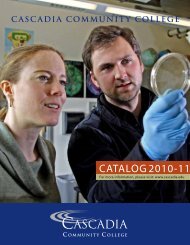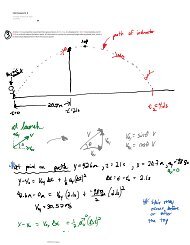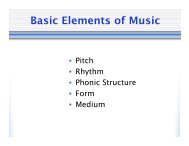You also want an ePaper? Increase the reach of your titles
YUMPU automatically turns print PDFs into web optimized ePapers that Google loves.
ASTR<br />
115<br />
03/12/13<br />
“Why does a volcanic eruption sometimes create lightning Pictured above, the Sakurajima volcano in southern Japan was caught erupting<br />
in early January. Magma bubbles so hot they glow shoot away as liquid rock bursts through the Earth's surface from below. The above image<br />
is particularly notable, however, for the lightning bolts caught near the volcano's summit. Why lightning occurs even in common<br />
thunderstorms remains a topic of research, and the cause of volcanic lightning is even less clear. Surely, lightning bolts help quench areas of<br />
opposite but separated electric charges. One hypothesis holds that catapulting magma bubbles or volcanic ash are themselves electrically<br />
charged, and by their motion create these separated areas. Other volcanic lightning episodes may be facilitated by charge-inducing collisions<br />
in volcanic dust. Lightning is usually occurring somewhere on Earth, typically over 40 times each second.”<br />
http://apod.nasa.gov/apod/ap130311.html<br />
Tuesday, March 12, 13<br />
1
“Is our Milky Way Galaxy out to lunch Recent wide field images and analyses now indicate that our home galaxy is actually still in the<br />
process of devouring its closest satellite neighbor. This unfortunate neighbor, the Sagittarius Dwarf galaxy, is now seen to be part of a larger<br />
Sagittarius Tidal Stream, a loose filament of stars, gas, and possibly dark matter that entangles the Milky Way. An artist's depiction of the<br />
stream is shown above. Speculation also holds that the Sagittarius Dwarf was once pulled through the Milky Way disk very close to our<br />
Sun's current location. An important resulting realization is that galaxies contain a jumble of clumps and filaments of both dim and dark<br />
matter.”<br />
http://apod.nasa.gov/apod/ap030930.html<br />
Tuesday, March 12, 13<br />
2
SCHEDULE CHANGES<br />
•The extra credit movie is now on Wednesday at 5:45-7:30pm.<br />
•The extra credit poster session at Edmonds may be changed to this<br />
Thursday at 6:15pm in stead of next Tuesday. This is still up in the air,<br />
so I will update the webpage on Wednesday with any changes.<br />
Tuesday, March 12, 13<br />
3
WHAT ARE QUASARS<br />
Tuesday, March 12, 13<br />
4
If the center of a<br />
galaxy is unusually<br />
bright, we call it an<br />
active galactic<br />
nucleus.<br />
Quasars are the<br />
most luminous<br />
examples.<br />
Active nucleus in Galaxy M87<br />
Tuesday, March 12, 13<br />
5
http://apod.nasa.gov/apod/ap100529.html<br />
“Violent galaxy mergers can feed supermassive black holes. Theoretically, the result is intense emission from regions near the supermassive black holes,<br />
creating the some of the most luminous objects in the universe. Astronomers dub these Active Galactic Nuclei, or just AGN. But for decades only about 1<br />
percent of AGN seemed to be associated with galaxy mergers. New results from a premier sky survey by NASA's Swift satellite at hard (energetic) X-ray<br />
energies now solidly show a strong association of AGN with merging galaxies, though. The hard X-rays more readily penetrate dust and gas clouds in merging<br />
galaxies and reveal the presence of emission from the active black holes. In fact, these panels show the location (circled) of Swift X-ray detected supermassive<br />
black holes in a variety of merging galaxy systems. The optical images are from the Kitt Peak National Observatory in Arizona. At top center is NGC 7319<br />
and the compact galaxy group known as Stephan's Quintet.”<br />
Tuesday, March 12, 13<br />
6
The highly redshifted spectra of quasars indicate large distances.<br />
From brightness and distance we find that luminosities of some<br />
quasars are greater than 10 12 L Sun .<br />
Variability shows that all this energy comes from a region smaller<br />
than our solar system.<br />
Tuesday, March 12, 13<br />
7
THOUGHT QUESTION<br />
What can you conclude from the fact that quasars usually<br />
have very large redshifts<br />
A. They are generally very distant.<br />
B. They were more common early in time.<br />
C. Galaxy collisions might turn them on.<br />
D. Nearby galaxies might hold dead quasars.<br />
Tuesday, March 12, 13<br />
8
THOUGHT QUESTION<br />
What can you conclude from the fact that quasars usually<br />
have very large redshifts<br />
A. They are generally very distant.<br />
B. They were more common early in time.<br />
C. Galaxy collisions might turn them on.<br />
D. Nearby galaxies might hold dead quasars.<br />
All of the above!<br />
Tuesday, March 12, 13<br />
9
Galaxies around<br />
quasars<br />
sometimes<br />
appear<br />
disturbed by<br />
collisions.<br />
Tuesday, March 12, 13<br />
10
Quasars powerfully radiate energy over a wide range of<br />
wavelengths, indicating that they contain matter with a wide<br />
range of temperatures.<br />
Tuesday, March 12, 13<br />
11
Radio galaxies contain active nuclei shooting out vast jets of<br />
plasma that emits radio waves coming from electrons that move<br />
at near light speed.<br />
Tuesday, March 12, 13<br />
12
The lobes of radio galaxies can extend over hundreds of<br />
thousands of light-years.<br />
Tuesday, March 12, 13<br />
13
An active galactic<br />
nucleus can shoot<br />
out blobs of plasma<br />
moving at nearly the<br />
speed of light.<br />
These ejection<br />
speeds suggests the<br />
presence of a black<br />
hole.<br />
Tuesday, March 12, 13<br />
14
Radio galaxies<br />
don’t appear as<br />
quasars because<br />
dusty gas clouds<br />
block our view<br />
of the accretion<br />
disk.<br />
Tuesday, March 12, 13<br />
15
CHARACTERISTICS OF<br />
ACTIVE GALAXIES<br />
•Their luminosities can be enormous (>10 12 L Sun ).<br />
•Their luminosities can rapidly vary (come from a space<br />
smaller than solar system).<br />
•They emit energy over a wide range of wavelengths (contain<br />
matter with a wide temperature range).<br />
•Some galaxies drive jets of plasma at near light speed.<br />
Tuesday, March 12, 13<br />
16
WHAT IS THE POWER SOURCE FOR QUASARS<br />
AND OTHER ACTIVE GALACTIC NUCLEI<br />
Tuesday, March 12, 13<br />
17
Accretion of gas onto a supermassive black hole appears to be<br />
the only way to explain all the properties of quasars.<br />
Tuesday, March 12, 13<br />
18
ENERGY FROM A BLACK HOLE<br />
•Gravitational potential energy of matter falling into black hole turns<br />
into kinetic energy.<br />
•Friction in an accretion disk turns kinetic energy into thermal energy<br />
(heat).<br />
•Heat produces thermal radiation (photons).<br />
•This process can convert 10 to 40% of<br />
E = mc 2 into radiation.<br />
Tuesday, March 12, 13<br />
19
Jets are thought to come from twisting of magnetic field in the<br />
inner part of accretion disk.<br />
Tuesday, March 12, 13<br />
20
DO SUPERMASSIVE BLACK<br />
HOLES REALLY EXIST<br />
Tuesday, March 12, 13<br />
21
Orbits of stars at<br />
center of Milky<br />
Way stars<br />
indicate a black<br />
hole with mass of<br />
4 million M Sun .<br />
Tuesday, March 12, 13<br />
22
The orbital speed and distance of gas orbiting the center of<br />
Galaxy M87 indicate a black hole with mass of 3 billion M Sun .<br />
Tuesday, March 12, 13<br />
23
BLACK HOLES IN GALAXIES<br />
•Many nearby galaxies—perhaps all of them—have<br />
supermassive black holes at their centers.<br />
•These black holes seem to be dormant active galactic nuclei.<br />
•All galaxies may have passed through a quasar-like stage earlier<br />
in time.<br />
Tuesday, March 12, 13<br />
24
GALAXIES AND BLACK<br />
HOLES<br />
•The mass of a<br />
galaxy’s central<br />
black hole is<br />
closely related to<br />
the mass of its<br />
bulge.<br />
Tuesday, March 12, 13<br />
25
GALAXIES AND BLACK<br />
HOLES<br />
•The development of<br />
the central black<br />
hole must be<br />
somehow related to<br />
galaxy evolution.<br />
Tuesday, March 12, 13<br />
26
HOW DO QUASARS LET US<br />
STUDY GAS BETWEEN THE<br />
GALAXIES<br />
Tuesday, March 12, 13<br />
27
Gas clouds between a quasar and Earth absorb some of the<br />
quasar’s light.<br />
We can learn about protogalactic clouds by studying the<br />
absorption lines they produce in quasar spectra.<br />
Tuesday, March 12, 13<br />
28
CHAPTER 22<br />
DARK MATTER, DARK ENERGY,<br />
AND THE FATE OF THE UNIVERSE<br />
Tuesday, March 12, 13<br />
29
WHAT DO WE MEAN BY DARK<br />
MATTER AND DARK ENERGY<br />
Tuesday, March 12, 13<br />
30
UNSEEN INFLUENCES<br />
<strong>Dark</strong> <strong>Matter</strong>: An undetected form of mass that emits little or no light,<br />
but whose existence we infer from its gravitational influence<br />
<strong>Dark</strong> Energy: An unknown form of energy that seems to be the<br />
source of a repulsive force causing the expansion of the universe to<br />
accelerate<br />
Tuesday, March 12, 13<br />
31
CONTENTS OF UNIVERSE<br />
•“Ordinary” matter: ~ 4.4%<br />
•Ordinary matter inside stars: ~ 0.6%<br />
•Ordinary matter outside stars: ~ 3.8%<br />
•<strong>Dark</strong> matter: ~ 23%<br />
•<strong>Dark</strong> energy ~ 73%<br />
Tuesday, March 12, 13<br />
32
WHAT IS THE EVIDENCE FOR DARK<br />
MATTER IN GALAXIES<br />
Tuesday, March 12, 13<br />
33
We measure the<br />
mass of the solar<br />
system using the<br />
orbits of planets:<br />
• orbital period<br />
• average distance<br />
For circles:<br />
• orbital velocity<br />
• orbital radius<br />
Tuesday, March 12, 13<br />
34
Rotation curve<br />
A plot of orbital<br />
velocity versus<br />
orbital radius<br />
The solar system’s<br />
rotation curve<br />
declines because<br />
the Sun has almost<br />
all the mass.<br />
Tuesday, March 12, 13<br />
35
Who has the<br />
largest orbital<br />
velocity<br />
A, B, or C<br />
Tuesday, March 12, 13<br />
36
Who has the<br />
largest orbital<br />
velocity<br />
A, B, or C<br />
Answer: C<br />
Tuesday, March 12, 13<br />
37
The rotation<br />
curve of a<br />
merry-go-round<br />
rises with<br />
radius.<br />
Tuesday, March 12, 13<br />
38
The rotation<br />
curve of the<br />
Milky Way stays<br />
flat with distance.<br />
Mass must be<br />
more spread out<br />
than in the solar<br />
system.<br />
Tuesday, March 12, 13<br />
39
Mass in the Milky<br />
Way is spread<br />
out over a larger<br />
region than its<br />
stars.<br />
Most of the Milky<br />
Way’s mass<br />
seems to be<br />
dark matter!<br />
Tuesday, March 12, 13<br />
40
Mass within the Sun’s<br />
orbit:<br />
1.0 × 10 11 M Sun<br />
Total mass:<br />
~10 12 M Sun<br />
Tuesday, March 12, 13<br />
41
The visible<br />
portion of a<br />
galaxy lies<br />
deep in the<br />
heart of a<br />
large halo of<br />
dark matter.<br />
Tuesday, March 12, 13<br />
42
We can<br />
measure the<br />
rotation<br />
curves of<br />
other spiral<br />
galaxies using<br />
the Doppler<br />
shift of the<br />
21-cm line of<br />
atomic<br />
hydrogen.<br />
Tuesday, March 12, 13<br />
43
Spiral galaxies all tend to have flat rotation curves, indicating<br />
large amounts of dark matter.<br />
Tuesday, March 12, 13<br />
44
Broadening of<br />
spectral lines in<br />
elliptical galaxies tells<br />
us how fast the stars<br />
are orbiting.<br />
These galaxies also<br />
have dark matter.<br />
Tuesday, March 12, 13<br />
45
THOUGHT QUESTION<br />
What would you conclude about a galaxy whose<br />
rotational velocity rises steadily with distance beyond<br />
the visible part of its disk<br />
A. Its mass is concentrated at the center.<br />
B. It rotates like the solar system.<br />
C. It’s especially rich in dark matter.<br />
D. It’s just like the Milky Way.<br />
Tuesday, March 12, 13<br />
46
THOUGHT QUESTION<br />
What would you conclude about a galaxy whose<br />
rotational velocity rises steadily with distance beyond<br />
the visible part of its disk<br />
A. Its mass is concentrated at the center.<br />
B. It rotates like the solar system.<br />
C. It’s especially rich in dark matter.<br />
D. It’s just like the Milky Way.<br />
Tuesday, March 12, 13<br />
47
WHAT IS THE EVIDENCE FOR DARK<br />
MATTER IN CLUSTERS OF GALAXIES<br />
Tuesday, March 12, 13<br />
48
We can measure<br />
the velocities of<br />
galaxies in a<br />
cluster from their<br />
Doppler shifts.<br />
Tuesday, March 12, 13<br />
49
The mass we find<br />
from galaxy<br />
motions in a<br />
cluster is about 50<br />
times larger than<br />
the mass in stars!<br />
Tuesday, March 12, 13<br />
50
Clusters contain large<br />
amounts of X rayemitting<br />
hot gas.<br />
Temperature of hot gas<br />
(particle motions) tells<br />
us cluster mass:<br />
85% dark matter<br />
13% hot gas<br />
2% stars<br />
Tuesday, March 12, 13<br />
51
Gravitational lensing, the bending of light rays by gravity, can<br />
also tell us a cluster’s mass.<br />
Tuesday, March 12, 13<br />
52
Tuesday, March 12, 13<br />
53
All three methods of measuring cluster mass indicate similar<br />
amounts of dark matter in galaxy clusters.<br />
Tuesday, March 12, 13<br />
54
THOUGHT QUESTION<br />
What kind of measurement does not tell us the mass of a<br />
cluster of galaxies<br />
A. measuring velocities of cluster galaxies<br />
B. measuring the total mass of cluster’s stars<br />
C. measuring the temperature of its hot gas<br />
D. measuring distorted images of background galaxies<br />
Tuesday, March 12, 13<br />
55
THOUGHT QUESTION<br />
What kind of measurement does not tell us the mass of a<br />
cluster of galaxies<br />
A. measuring velocities of cluster galaxies<br />
B. measuring the total mass of cluster’s stars<br />
C. measuring the temperature of its hot gas<br />
D. measuring distorted images of background galaxies<br />
Tuesday, March 12, 13<br />
56
DOES DARK MATTER<br />
REALLY EXIST<br />
Insert TCP 6e Figure 22.11<br />
unannotated<br />
Tuesday, March 12, 13<br />
57
OUR OPTIONS<br />
1. <strong>Dark</strong> matter really exists, and we are observing the effects of<br />
its gravitational attraction.<br />
2. Something is wrong with our understanding of gravity,<br />
causing us to mistakenly infer the existence of dark matter.<br />
Tuesday, March 12, 13<br />
58
OUR OPTIONS<br />
1. <strong>Dark</strong> matter really exists, and we are observing the effects of<br />
its gravitational attraction.<br />
2. Something is wrong with our understanding of gravity,<br />
causing us to mistakenly infer the existence of dark matter.<br />
Because gravity is so well tested, most astronomers prefer<br />
option #1.<br />
Tuesday, March 12, 13<br />
59
Some observations of the universe are very difficult to<br />
explain without dark matter.<br />
Tuesday, March 12, 13<br />
60
WHAT MIGHT DARK MATTER<br />
BE MADE OF<br />
Tuesday, March 12, 13<br />
61
HOW DARK IS DARK MATTER<br />
… NOT AS BRIGHT AS A STAR.<br />
Tuesday, March 12, 13<br />
62
TWO BASIC OPTIONS<br />
•Ordinary <strong>Dark</strong> <strong>Matter</strong> (MACHOS)<br />
•Massive Compact Halo Objects:<br />
dead or failed stars in halos of galaxies<br />
•Extraordinary <strong>Dark</strong> <strong>Matter</strong> (WIMPS)<br />
•Weakly Interacting Massive Particles:<br />
mysterious neutrino-like particles<br />
Tuesday, March 12, 13<br />
63
TWO BASIC OPTIONS<br />
•Ordinary <strong>Dark</strong> <strong>Matter</strong> (MACHOS)<br />
•Massive Compact Halo Objects:<br />
dead or failed stars in halos of galaxies<br />
•Extraordinary <strong>Dark</strong> <strong>Matter</strong> (WIMPS)<br />
•Weakly Interacting Massive Particles:<br />
mysterious neutrino-like particles<br />
The<br />
best<br />
bet<br />
Tuesday, March 12, 13<br />
64
MACHOs<br />
occasionally make<br />
other stars appear<br />
brighter through<br />
lensing…<br />
… but there are<br />
not enough<br />
lensing events to<br />
explain all the<br />
dark matter.<br />
Tuesday, March 12, 13<br />
65
WHY BELIEVE IN WIMPS<br />
•There’s not enough ordinary matter.<br />
•WIMPs could be left over from Big Bang.<br />
•Models involving WIMPs explain how galaxy formation works.<br />
Tuesday, March 12, 13<br />
66
WHAT IS THE ROLE OF DARK MATTER<br />
IN GALAXY FORMATION<br />
Tuesday, March 12, 13<br />
67
Gravity of dark matter is what caused protogalactic clouds to<br />
contract early in time.<br />
Tuesday, March 12, 13<br />
68
Insert TCP 6e Figure 22.2<br />
WIMPs can’t<br />
collapse to the<br />
center because<br />
they don’t<br />
radiate away<br />
their orbital<br />
energy.<br />
Tuesday, March 12, 13<br />
69
<strong>Dark</strong> matter is still<br />
pulling things<br />
together.<br />
After correcting<br />
for Hubble’s law,<br />
we can see that<br />
galaxies are<br />
flowing toward<br />
the densest<br />
regions of space.<br />
Tuesday, March 12, 13<br />
70
WHAT ARE THE LARGEST STRUCTURES<br />
IN THE UNIVERSE<br />
Tuesday, March 12, 13<br />
71
Maps of galaxy positions reveal extremely large structures:<br />
superclusters and voids.<br />
Tuesday, March 12, 13<br />
72
Time in billions of years<br />
0.5 2.2 5.9 8.6 13.7<br />
13 35 70 93 140<br />
Size of expanding box in millions of light-years<br />
Models show that gravity of dark matter pulls mass into denser<br />
regions—the universe grows lumpier with time.<br />
Tuesday, March 12, 13<br />
73
Models show that gravity of dark matter pulls mass into denser<br />
regions—universe grows lumpier with time.<br />
Tuesday, March 12, 13<br />
74
Structures in galaxy maps look very similar to the ones found in<br />
models in which dark matter is WIMPs.<br />
Tuesday, March 12, 13<br />
75
“The latest map of the cosmos again indicates that dark matter and dark energy dominate our universe. The Sloan Digital Sky Survey<br />
(SDSS) is on its way to measuring the distances to over one million galaxies. Galaxies first identified on 2D images, like the one shown<br />
above on the right, have their distances measured to create the 3D map. The SDSS currently reports 3D information for over 200,000<br />
galaxies, now rivaling the 3D galaxy-count of the Two-Degree Field sky map. The latest SDSS map, shown above on the left, could only<br />
show the galaxy distribution it does if the universe was composed and evolved a certain way. After trying to match many candidate universes<br />
to it, the Cinderella universe that best fits the above map has 5% atoms, 25% dark matter, and 70% dark energy. Such a universe was<br />
previously postulated because its rapid recent expansion can explain why distant supernovas are so dim, and its early evolution can explain<br />
the spot distribution on the very distant cosmic microwave background.”<br />
http://apod.nasa.gov/apod/ap031028.html<br />
Tuesday, March 12, 13<br />
76
http://apod.nasa.gov/apod/ap070827.html<br />
“What has created this huge empty volume in the universe No one is yet sure, and even the extent of the estimated billion-light year void<br />
is being researched. The void is not a hole in space like a black hole, but rather a vast region of the universe that appears to be mostly<br />
devoid of normal matter and even dark matter. The void is still thought to contain dark energy, though, and is clearly traversable by light.<br />
The void's existence is being postulated following scientific curiosity about how unusually cold spots came to appear on WMAP's map of<br />
cosmic microwave background (CMB) radiation. One possibility was that this CMB region was not actually very cold but light from the<br />
spot somehow became more cosmologically redshifted than normal along the way. Other voids in the universe are known to exist, but this<br />
void appears to have an unusually large gravitational effect, and so might possibly be the largest in our entire visible universe.<br />
Investigating this, a recent study found an unusually low number of cosmic radio sources between Earth and the CMB cold spot, which<br />
led to the inference of this giant void. An artist's depiction of the huge cosmic void is shown above.”<br />
Tuesday, March 12, 13<br />
77
WILL THE UNIVERSE CONTINUE<br />
EXPANDING FOREVER<br />
Tuesday, March 12, 13<br />
78
Does the<br />
universe have<br />
enough kinetic<br />
energy to escape<br />
its own<br />
gravitational pull<br />
Tuesday, March 12, 13<br />
79
The fate of<br />
the universe<br />
depends on<br />
the amount of<br />
dark matter.<br />
Tuesday, March 12, 13<br />
80
Since the amount of dark<br />
matter is ~25% of the<br />
critical density, we expect<br />
the expansion of the<br />
universe to overcome its<br />
gravitational pull.<br />
Tuesday, March 12, 13<br />
81
In fact, the<br />
expansion appears<br />
to be speeding up!<br />
<strong>Dark</strong><br />
energy<br />
Tuesday, March 12, 13<br />
82
Estimated age depends on the amount of both dark matter<br />
and dark energy.<br />
Tuesday, March 12, 13<br />
83
THOUGHT QUESTION<br />
Suppose that the universe has more dark matter than we<br />
think there is today. How would this change the age<br />
we estimate from the expansion rate<br />
A. The estimated age would be larger.<br />
B. The estimated age would be the same.<br />
C. The estimated age would be smaller.<br />
Tuesday, March 12, 13<br />
84
THOUGHT QUESTION<br />
Suppose that the universe has more dark matter than we<br />
think there is today. How would this change the age<br />
we estimate from the expansion rate<br />
A. The estimated age would be larger.<br />
B. The estimated age would be the same.<br />
C. The estimated age would be smaller.<br />
Tuesday, March 12, 13<br />
85
IS THE EXPANSION OF THE<br />
UNIVERSE ACCELERATING<br />
Tuesday, March 12, 13<br />
86
Insert TCP 6e Figure 20.14<br />
The brightness of distant white dwarf supernovae tells us how<br />
much the universe has expanded since they exploded.<br />
Tuesday, March 12, 13<br />
87
An accelerating universe best fits the supernova data.<br />
Tuesday, March 12, 13<br />
88
http://apod.nasa.gov/apod/ap071021.html<br />
“How will our universe end Recent<br />
speculation now includes a pervasive growing<br />
field of mysterious repulsive phantom energy<br />
that rips virtually everything apart. Although<br />
the universe started with a Big Bang, analysis<br />
of cosmological measurements allows a<br />
possibility that it will end with a Big Rip. As<br />
soon as few billion years from now, the<br />
controversial scenario holds, dark energy will<br />
grow to such a magnitude that our own Galaxy<br />
will no longer be able to hold itself together.<br />
After that, stars, planets, and then even atoms<br />
might not be able to withstand the expansive<br />
internal force. Previously, speculation on the<br />
ultimate fate of the universe centered on either<br />
a re-collapsing Big Crunch or a Big Freeze.<br />
Although the universe's fate is still a puzzle,<br />
piecing it together will likely follow from an<br />
increased understanding of the nature of dark<br />
matter and dark energy.”<br />
Tuesday, March 12, 13<br />
89
NOW -- TO IMPORTANT<br />
MATTERS<br />
HOW COULD ASTRONOMICAL EVENTS<br />
KILL ALL LIFE ON EARTH<br />
(NOTE: APPROPRIATE FOR ALL AGES, AND NOT SOMETHING TO<br />
LOSE ANY SLEEP OVER)<br />
Tuesday, March 12, 13<br />
90
IN NO PARTICULAR ORDER (IGNORING<br />
HUMANITIES OWN ATTEMPTS TO DESTROY<br />
LIFE ON EARTH)<br />
•Killer asteroid<br />
•Volcanoes<br />
•Gamma-ray burst<br />
•Supernova explosion<br />
•Super solar flares<br />
•Earth’s magnetic field flipping<br />
•Sun’s temperature increases to the point that Earth is no longer in the<br />
habitable zone.<br />
•Galactic collision<br />
Tuesday, March 12, 13<br />
91
KILLER ASTEROIDS<br />
•Small impacts happen<br />
almost daily.<br />
•Impacts large enough to<br />
cause mass extinctions<br />
happen many millions of<br />
years apart.<br />
•Bigger than 10km, and<br />
all humans at least will<br />
die.<br />
In about 1.7 million years, Giliese 710 is predicted to pass within 1.1 light<br />
years of our Sun.<br />
Tuesday, March 12, 13<br />
92
SUPER VOLCANOS<br />
•A super volcano eruption is considered to be ten times more likely in<br />
the (near) future than a killer asteroid impact.<br />
•Yellowstone erupts approximately every 600,000 years.<br />
•Last eruption: 640,000 years ago...<br />
•Yellowstone is a 34 mile by 45 mile active volcanic caldera.<br />
•Volcanic ash could block most of the sunlight across the entire<br />
planet for years. (volcanic winter)<br />
•Could even trigger a runaway greenhouse effect.<br />
Tuesday, March 12, 13<br />
93
NEARBY SUPERNOVA<br />
EXPLOSION<br />
•While theorists disagree on the exact number, typically they say that if<br />
a supernova occurred within 30 light-years of us (assuming the jet is<br />
not pointed at us) then mass extinctions could occur here on Earth.<br />
•The closest star expected to go supernova any time soon is 500 light<br />
years away. At that distance, even if the jet was pointed at us it is<br />
unlikely to do more than perhaps cause some technology issues<br />
(those sensitive satellites).<br />
Tuesday, March 12, 13<br />
94
GAMMA-RAY BURST<br />
•To see a gamma-ray burst, the jet has to be pointed directly at us.<br />
•At about 1000 lightyears it would be as bright as our Sun (in visible<br />
light).<br />
•Even at that distance they could cook the atmosphere, creating nitrous<br />
oxides that would destroy the ozone layer. Without the ozone layer, it<br />
would only be a matter of time until we died from the radiation of<br />
our own Sun.<br />
•If it was closer, the effects could kill us even faster.<br />
•BUT, there are no known progenitors of gamma-ray bursts in our part<br />
of the galaxy.<br />
Tuesday, March 12, 13<br />
95
SUPER SOLAR FLARES<br />
•Some tentative evidence that they can happen on sun-like stars. (They<br />
briefly brightened by a factor of 20.)<br />
•But stars tend to become less active as they age.<br />
•The flare would also have to be aimed at Earth.<br />
•Within a few hours the super solar flare could fry the side of Earth<br />
facing the sun, and destroy the ozone layer (so even on the night-side<br />
of the planet you would eventually die).<br />
Tuesday, March 12, 13<br />
96
EARTH’S MAGNETIC FIELD<br />
FLIPPING<br />
•Obviously, this will not kill all life on earth, but it could kill humanity, or<br />
at least our current civilization.<br />
•On average it flips every 250,000 years (but it could occur on<br />
timescales of 100’s of years).<br />
•It’s been 780,000 years since the last reversal.<br />
•For some length of time during the flip, the Earth has no magnetic<br />
field (days/months/years/decades we have no idea).<br />
•During this time we would have no protection from the solar<br />
wind.<br />
Tuesday, March 12, 13<br />
97
GALACTIC COLLISION<br />
•Andromeda is heading toward the Milky way at about 140 km/s (87<br />
miles/sec)<br />
•Impact expected in about 3 billion years.<br />
•May or may not cause difficulties here in our solar system.<br />
•Close encounters with other stars could modify the orbits of all or<br />
some (Jupiter) of the planets.<br />
•Don’t worry though, we’ll be dead by then :-)<br />
Tuesday, March 12, 13<br />
98
SUN HEATING UP<br />
•Regardless of all the other factors, this one WILL kill us. (Unless we<br />
can move to another planet, or physically move our planet to a<br />
different orbit).<br />
•As the sun heats up over time, it changes the climate here on Earth.<br />
•Eventually as the habitable zone moves past the Earth, we will<br />
experience the same sort of runaway greenhouse effect that Venus<br />
experienced.<br />
•optimist view: 3 billion years from now<br />
•pessimist view: ~1 billion years from now (includes water in the<br />
model)<br />
Tuesday, March 12, 13<br />
99
OTHER THINGS<br />
(INCLUDING THE LEAST LIKELY ASTRONOMY)<br />
•Global nuclear warfare ---> kills most life on earth.<br />
•Global epidemic ---> could kill all humans on earth.<br />
•Global climate change (Global warming)---> early runaway<br />
greenhouse effect could kill all life on earth.<br />
•Mercury’s orbit gets disturbed by Jupiter (1% chance) and hits the<br />
Earth (very unlikely) ---> destroys the planet.<br />
•The solar system has a very close encounter with a star/planet/black<br />
hole ---> could destroy the planet.<br />
•AI’s or aliens kill us all (hey, it could happen) ---> destroys humans.<br />
Tuesday, March 12, 13<br />
100











